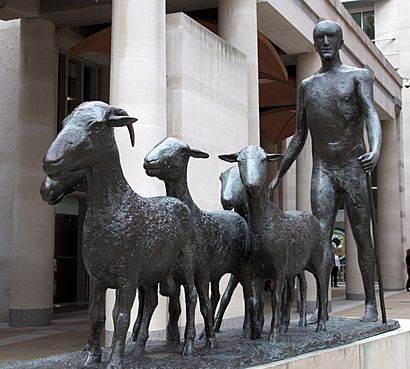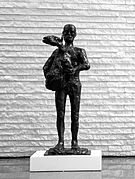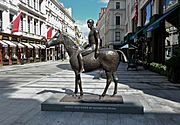Paternoster (sculpture) facts for kids
Quick facts for kids Paternoster |
|
|---|---|

The sculpture in 2012
|
|
| Artist | Elisabeth Frink |
| Year | 1975 |
| Type | Sculpture |
| Medium | Bronze |
| Location | London, EC4 United Kingdom |
| 51°30′53″N 0°05′56″W / 51.514647°N 0.098892°W | |
Paternoster, also known as Shepherd and Sheep or Shepherd with his Flock, is a large bronze sculpture. It was created in 1975 by the artist Elisabeth Frink. You can find it outdoors in Paternoster Square in London, close to the famous St Paul's Cathedral.
Contents
About the Sculpture
This impressive statue is about 84 by 129 by 32 inches (213 cm × 328 cm × 81 cm) in size. It shows a shepherd leading five sheep. The shepherd's appearance is neutral, meaning they could be a man or a woman.
What the Sculpture Means
The sculpture's subject, a shepherd and sheep, connects to the history of the area. Long ago, Paternoster Row was home to Newgate Market. This market was a place where livestock, like sheep, and meat were sold.
The statue might also have a religious meaning. It stands near St Paul's Cathedral, a very important church. In Christianity, the idea of a "Good Shepherd" is a symbol of guidance and care. The name "Paternoster" comes from a Latin prayer meaning "Our Father." This links to the word "pastor," which also means shepherd.
Inspiration for the Art
Elisabeth Frink might have found inspiration for Paternoster from different places. She spent time in the Cévennes region of France, where farming and shepherding are common. The sculpture might also be a nod to Pablo Picasso's 1944 sculpture, Man with Sheep.
History of the Sculpture
The Paternoster sculpture was ordered by a company called Trafalgar House. They wanted it for their new buildings in Paternoster Square in the 1960s.
Unveiling and Relocation
The statue was officially revealed in July 1975 by Yehudi Menuhin, a famous musician. He said the sculpture was very different from the buildings around it. Around the same time, Trafalgar House also asked Frink to create another statue, Horse and Rider, which was placed in Piccadilly.
In 1997, Paternoster was moved to a temporary spot near the Museum of London. This was because Paternoster Square was being rebuilt. Once the redevelopment was finished, the sculpture was brought back in 2003. It was placed on a new base made of Portland stone.
Smaller Versions
In the 1980s, Elisabeth Frink created a series of eight smaller statues similar to Paternoster. One of these smaller sculptures can be found at All Saints Church in Great Thurlow, Suffolk. Frink herself was born near Great Thurlow.



